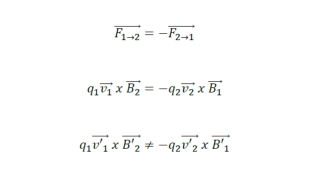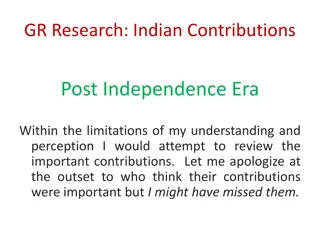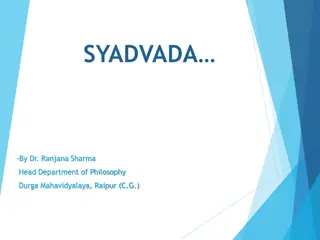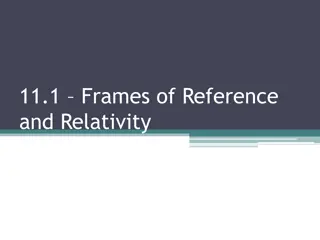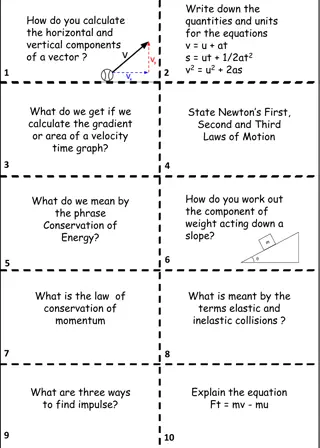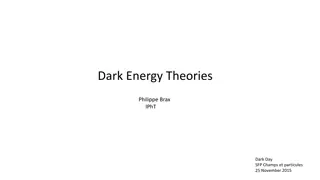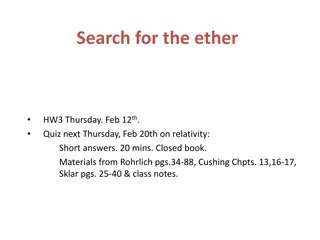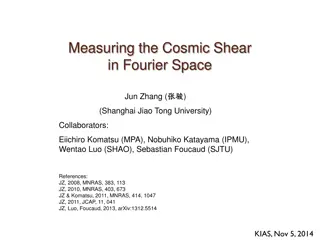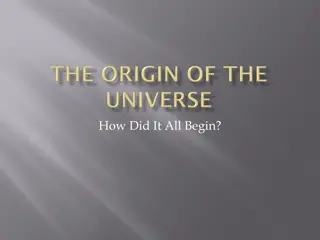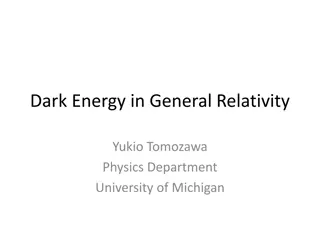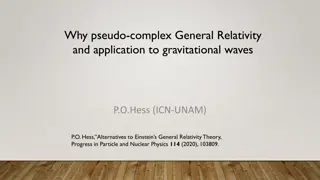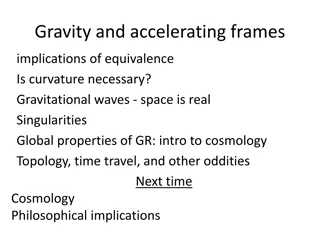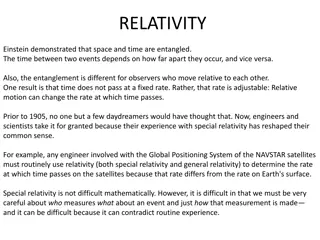Understanding Special Relativity and Its Implications
Explore the key principles of special relativity, including Galileo's principle of relativity and Einstein's principle of relativity. Dive into concepts like length contraction, momentum and energy conservation, and the invariance of mass-energy. Witness how observers inside and outside moving frames experience light and objects differently, leading to fascinating phenomena like time dilation and length contraction in the realm of relativity.
Download Presentation

Please find below an Image/Link to download the presentation.
The content on the website is provided AS IS for your information and personal use only. It may not be sold, licensed, or shared on other websites without obtaining consent from the author. Download presentation by click this link. If you encounter any issues during the download, it is possible that the publisher has removed the file from their server.
E N D
Presentation Transcript
Galileos Principle of Relativity The laws of mechanics must be the same in all inertial reference frames Time is the same across all reference frames Simple addition of velocities between frames
Einsteins Principle of Relativity The laws of physics must be the same in all inertial reference frames The speed of light in vacuum has the same value in all inertial frames, regardless of the velocity of the observer or the velocity of the source emitting the light
An observer inside a moving train views a ray of light as follows: mirror d v ? =2? c ? = 2d ?
An observer outside a moving train, on the ground, at rest views a ray of light as follows: v d 2 ?2+?2?2 (c t )2= 4 ?2+?2?2 ? 1 ?2 4 ? = = 4 ? ?2
Length contraction Imagine a spaceship travelling at speed v between two stars a distance x apart (as measured in the rest frame of the stars) An observer at rest relative to the stars sees the trip take a time t= x/v The observer in the spaceship also sees t = x /v where v is the same for both frames ? 1 ?2 We know from time dilation that t = ?2 Thus the measured lengths must be different as well! The observer on the spaceship sees a contracted length x = x (1-v2/c2) 1 The factor is so useful in relativity it s given it s own symbol 1 ?2 ?2 For time dilation t = t and for length contraction x = x/
Momentum & Energy Changing your frame of reference will create an observable change in momentum and energy, but they are both still conserved. Invariant mass energy ?2= ?2?2+ (??2)2 Not affected by reference frame (??2)2= ?2 ?2?2 Energy and momentum are not conserved separately, but as a combination This implies that for a particle at rest: ? = ??2 !!!!
Momentum & Energy There is energy in mass Consider a person weighing 100 kg: ? = (100??)(3?108? ?)2 ? = 9?1018? A few kilograms of fuel of a nuclear source is worth a few tons of fuel of a chemical source A useful relationship for relativistic momentum and energy: ? = ?? ? ?? = ? 1 ??2
ct An object sitting at rest, whose position (x) stays the same x ct An object with some velocity, v x
= 45 when the object is moving at the speed of light ?? = ? ? =? ? A real object with mass cannot travel at the speed of light Light has no mass So, a real object cannot go beyond 45 from the y axis, in either direction
Elsewhere FUTURE E L S E W H E R E E L S E W H E R E PAST
Strict Causality C=3x108m/s t X 100 ly Planet X is 100 ly away. 9.46?1015? t= ? If a signal were sent from earth, at the speed of light, it would take Planet X 100 years to be able to recognize the signal 3?108? ? ?= 100?? ?= 100 ????? 1 ??
ct ct If an object, ct , is moving and another object, ct is at rest, relative to ct , it looks like ct is moving Tilted Axis ct x=ct Spacetime distance between 2 points: x s2= x2 + y2 + z2 - (ct)2 The speed of light is the same for all axis
Consequences 1. The pole in the barn effect v 100 m 100 m The pole and barn both see each other as being less than 100 m by the gamma factor. At some instance the doors of the barn could be closed and opened, trapping the pole in the barn. The pole sees the doors of the barn close one at a time, and open one at a time
Twin B Leaves on a rocket to mars. Twin A sees twin B as moving close to the speed of light; he sees twin B as 21 and himself as 25. When the rocket turns around, twin 2 sees himself as 25 and twin A as 21. 2. Twin Paradox A B 20 years old 20 years old Once things accelerate, they are no longer in the inertial reference frame. General Relativity deals with accelerated reference frames.
General Relativity a=9.8m/?2 g=9.8m/?2 A person in an elevator ascending at 9.8m/?2 would feel no different than a person in an elevator at rest. They could not determine whether the force they were feeling was from the acceleration of the elevator or the force due to gravity.
Adding Velocities v2 v1 A person standing on an island wants to know how fast a canon ball is coming toward them. Classical version: v1 + v2 = v Relativistic version: ??+?? = ? ?+???? ?? If the canon were a photon torpedo from the starship enterprise moving at the speed of light: ??+? ?+??? ?? ? = ? =??+? =??+? ? ?+?? ??+? ??+? = ? = ? ?+?? ?
Equations to Know 1 Momentum & Energy: ? = ?? ? Special Relativity: ? = 1 ?2 ?? = ? 1 ??2 ?2 Time Dilation: ? = ? ? ??+?? ?+???? = ? Adding Velocities: ?? Length Contraction: ? = ? ?


